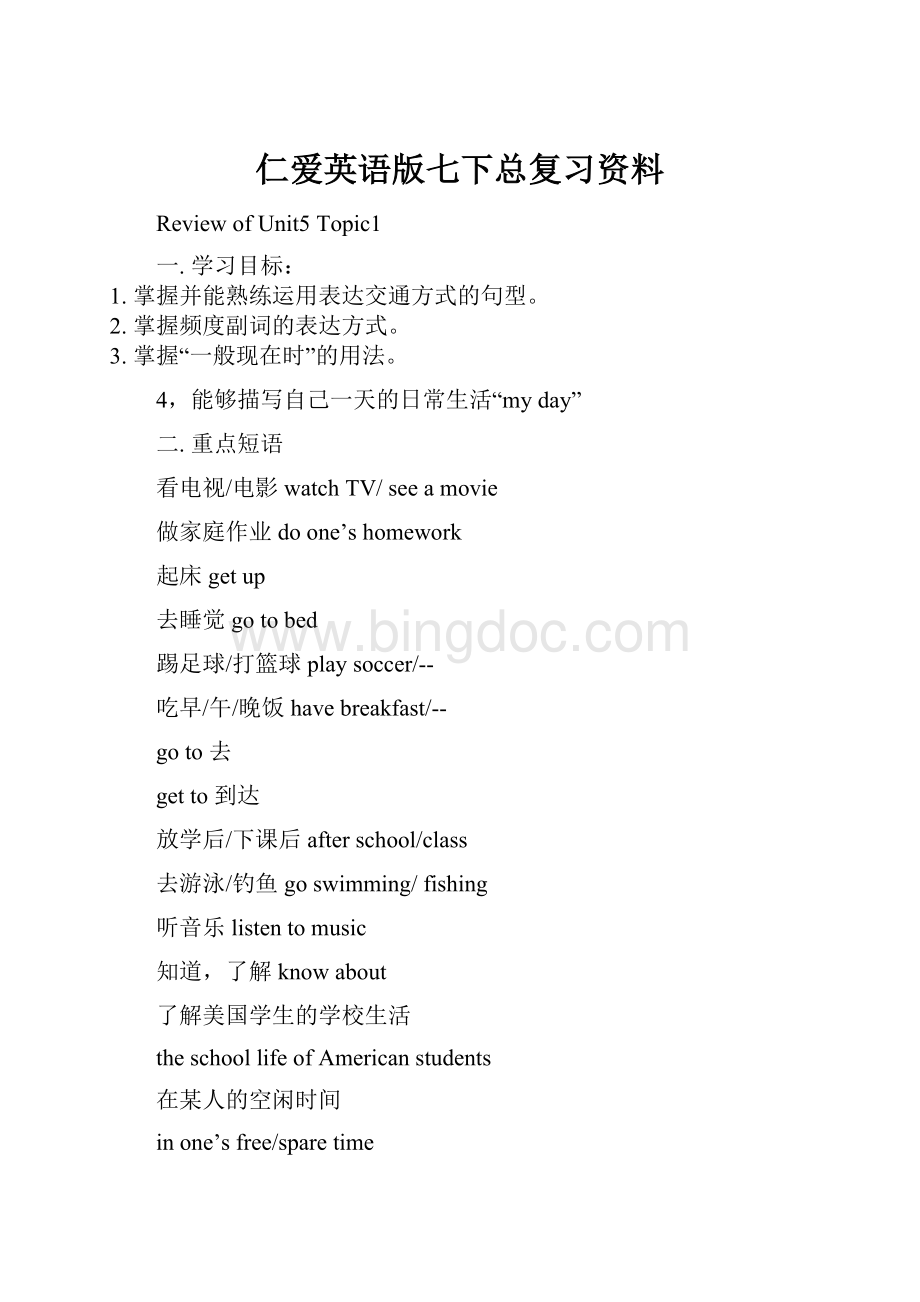仁爱英语版七下总复习资料.docx
《仁爱英语版七下总复习资料.docx》由会员分享,可在线阅读,更多相关《仁爱英语版七下总复习资料.docx(34页珍藏版)》请在冰点文库上搜索。

仁爱英语版七下总复习资料
ReviewofUnit5Topic1
一.学习目标:
1.掌握并能熟练运用表达交通方式的句型。
2.掌握频度副词的表达方式。
3.掌握“一般现在时”的用法。
4,能够描写自己一天的日常生活“myday”
二.重点短语
看电视/电影watchTV/seeamovie
做家庭作业doone’shomework
起床getup
去睡觉gotobed
踢足球/打篮球playsoccer/--
吃早/午/晚饭havebreakfast/--
goto去
getto到达
放学后/下课后afterschool/class
去游泳/钓鱼goswimming/fishing
听音乐listentomusic
知道,了解knowabout
了解美国学生的学校生活
theschoollifeofAmericanstudents
在某人的空闲时间
inone’sfree/sparetime
一小会儿foralittlewhile
读书readabook/books
在周末on/atweekends
在平时/工作日onweekdays
见朋友meetfriends
(注意:
one’s代表某人的。
此处为形物代或名词所有格。
如:
my,your,his,her,its,Michael’s,Maria’s---)
三.重点句子
Comeon!
Howdoyouusuallycometoschool?
Iusuallycometoschoolonfoot.
Theearlybirdcatchestheworm.
HappyNewYear!
Thesametoyou.
Nicetoseeyouagain.Nicetoseeyou,too.
Ialwayscometoschoolbysubway.(否定)
I______cometoschoolbysubway.
Classesbeginateight.
Wehavefourclassesinthemorning.
Nicetalkingtoyou./Nicetotalktoyou.
I’msorryIhavenomoretime.(nomore=not---anymore)
=I’msorryIdon’thaveanymoretime.
Whattimedoyouusuallygetuponweekdays?
Iusuallygetupat6:
00.
与what相关的特殊疑问词词组:
Whattime问时间
问颜色Whatcolor问班级Whatclass
问年级Whatgrade问星期Whatday
四.疑难讲解
1.交通方式的表达
go/cometo+地点+by+交通工具
=go/cometo+地点+in/ona/an/the+交通工具
=takea/an/the+交通工具+to+地点
rideabiketo
driveacarto
walkto
flyto
Eg:
Iusauallycometoschoolbybus.
=Iusually______________toschool.
=Iusually_____toschool__________________.
提问:
Howdoyouusuallycometoschool.
2.频率副词:
always,usually,often,sometimes,seldom,never.通常放在句中be,来modal.v,助动词之后,行为动词之前。
为表强调,有时也可放句首。
频率的其它表示方法:
次数+时间段
Eg;onceaweek;twiceaweek;threetimesaday;fourtimesayear
Eg:
IwatchTVtwiceaweek.
__________doyouwatchTV?
3.该做---的时候了。
It’stimeforsth.
=it’stimefordoingsth.
=it’stimetodosth.
Eg:
It’stimeforclass.
It’stime_________________.
It’stime_________________.
4.in,on,at表时间的用法
in月季年,早中晚
on日期,星期,节日前,具体某天早中晚
at中午,午夜,时刻前
_____themorning/afternoon/evening____Sunday_____February____12:
00____Christimas____asnowymorning
ReviewofUnit5Topic2
一.学习目标
1.掌握现在进行时的用法
2.学会谈论校园活动
3.能用现在进行时写一篇文章
二.重点短语
做卡片makecards/acard
呆会儿见seeyousoon.
在操场上ontheplayground
在游泳池intheswimmingpool
在书架上ontheshelf
做扫除dosomecleaning
举行一场足球比赛haveasoccergame
在失物招领处attheLostandFound
那边overthere
擦黑板cleantheblackboard
在---的后面atthebackof
画画drawpictures/apicture
写信writealetter
在长城上ontheGreatWall
一个日本/中国女孩aJapanesegirl
一个美国/英国男孩anAmericanboy
love/likedoingsth
和某人交谈talkto/withsbshowsbaround带领某人参观
谈论某事talkaboutsth
三.重点句子
1.Excuseme,mayIborrowyourstorybook?
Ofcourse.=Sure.(borrowsthfrom…从……借回某物……)
2.HowLongcanIkeepthem?
Twoweeks.(howlong对时间段提问。
只能和延续性动词连用。
所以此处不能用瞬间动词borrow,必须替换为相应的keep.)
3.Youmustreturnthemontime.(return归还,returnsthto…把……归还给……)
4.Thankyou.It’sapleasure.=Apleasure=Mypleasure.别客气。
5.Thankyouallthesame.仍然感谢你。
(用于别人不能帮你或你不需要别人的帮助时)
6.Seeyousoon.回头/呆会见.Seeyoutomorrow.明天见。
7.Whatelsecanyoudo?
你还会做别的什么?
Whatelse?
还有别的什么?
(else其他的、别的,常放在疑问词what/where/who…和不定代词something/somebody等的后面)
四,疑难讲解
1.现在进行时:
表说话时正在进行的动作。
谓语动词形式:
be(am,is,are)+V-ing(动词-ing形式的构成规则?
)
常见时状:
now,atthemoment,look,listen
Eg:
Wearestudying.
否定句:
一般疑问句:
特殊疑问句:
2.Wouldyouliketoplaybasketball?
表征求意见建议的句型。
(注意各句型后动词的不同形式)
•Wouldyouliketodosth?
•How/Whatabout(doing)sth?
•Whynotdosth?
•Whydon’tyoudosth?
•Let’sdosth.
•_______________playbasketball?
•___________playingbasketball?
•_____playbasketball?
•__________playbasketball?
3.MayIborrowsomeEnglishworkbooks?
情态动词can,could,will,would,may,must+V-原。
borrowsthfrom----从----借---
borrow和keep
borrow是瞬间动词,不能和时间段连用
keep是延续性动词,可以和时间段连用
HowlongcanIkeepthem?
Howlong多久,对时间段提问
Youcanstayherefortwoweeks.
__________canIstayhere?
4.Youmustreturnthemontime.你必须按时归还它们。
Return意为“归还,回归”
returnsth.tosb.把某物归还某人=returnsbsth=givebacksth.tosb.
Eg:
Returnmymoneytome.
Returnbookstothelibraryontime.
returnto“回到…”,相当于comebackto…
回到云阳:
returntoYunyang回学校:
returntoschool回家:
returnhome5.lookfor和find
lookfor强调找的动作和过程,
find强调找的结果
Heis__________hiswallet,buthecan’t________it
6.few,afew,little,alittle
few,afew+可复
little,alittle+不可数名词
few,little表否定,意为“没有多少,几乎没有”
afew,alittle表肯定,意为“有一些”
Heisnew,sohehas______friends.
Thereis______milkinthebottle.Ihavetobuysome.
Hehas______money,sohewantstobuyacar.
7.what’s+介词短语?
询问某处有什么东西?
Eg:
What’sinyourdesk?
Somebooks.
8.want=wouldlike
wantsth=wouldlikesth想要---
wanttodosth=wouldliketodosth想要做----
wantsbtodosth=wouldlikesbtodosth想要某人---
9.also,too,either也
Ilikemusic,helikesmusic,______.
Ilikemusic,he______likesmusic.
Idon’tlikeP.E,hedoesn’tlikeP.E,______.
10.Herearesomephotosofhis.这有他的一些照片。
photosofhis是双重所有格(即of后跟名词性物主代词或名词所有格)。
afriendofmine我的一个朋友aclassmateofmybrother’s我弟弟的一个同学
11.Helookshappybecausehelovesswimming.(对划线部分提问)
__________helookhappy?
because和so
Welikeourschool_______it’sbeautiful.
Ourschoolisbeautiful_____welikeit.
ReviewofUnit5Topic3
一.学习目标
1.掌握词汇:
星期,科目等
2,能够区分“一般现在时”和“现在进行时”
3,能够用正确的时态描写“myschoollife”
4,能够制作海报
5,掌握书信的基本格式。
二.重点短语
了解过去learnaboutthepast
解数学难题workoutmathproblems
户外运动outdooractivities
请注意啦!
Attention,please
在A和B之间betweenAandB
从----到---from---to----
differentkindsof
manykindsof
akindof
learn----from---向---学习
learntodo学习做---
对---友好bekind/friendly/niceto---
上课haveclasses
上一堂英语/美术课
HaveanEnglish/artclass
三.重点句子
1.Whatdayisittoday?
今天星期几?
/今天是什么节日?
It’s-----
2.询问别人的看法:
Whatdoyouthinkof----?
=Howdoyoulike---?
举一反三:
Whatdoeshethinkof----?
=
3.favorite=like---best最喜欢----
Englishismyfavoritesubject.
IlikeEnglishbest.
What’syourfavoritesubject.
=Whichsubjectdoyoulikebest?
6.Whattimedoestheclassbegin?
Whattimeistheclassover?
beover结束Theclassisover.下课了。
7.Couldyoupleasetellmesomethingaboutit?
8.Whatclassaretheyhaving?
Theyarehavinganart/Englishclass.
四,疑难讲解
1.
现在进行时
一般现在时
定义
表说话时正在进行的动作
表经常性,习惯性的动作或性质,状态,特征
谓语形式
be(am,is,are)+doing
V-原或三单
常见时状
now,atthemoment,
look,listen
always,usually,often,everyday/Sunday.
用法:
1,表说话时正在进行的动作。
Wearestudying.
2。
表现阶段正在进行而说话时并不一定在进行的动作。
I’mlearningJapanesethesedays.
1.表经常性,习惯性的动作或状态,特征eg:
Sheisnice.
Ioftengetupearly.
2.表客观事实,真理。
Theearthgoesaroundthesun.
1.We____(do)ourhomeworkeveryday.Nowwe________(do)ourhomeworkintheclassroom.
2.SometimesLiPing____(have)lunchathome.Butnowhe________(have)lunchatschool.
3.Sometimesthey_____(watch)TVafterschool.Butnowthey______________(notwatch)TV.They__________(play)games.
4.Mysister_____(read)Englisheverymorning.Butnowshe_________(read)Chinese.
2.Thankyouforyourhardwork.
Thanksbfor(doing)sth---因为---感谢某人
Eg:
Thankyouforhelpingme.
Thankyouforyourhelp.
3.look,see,read,watch
look强调看的动作。
常用于以下短语中。
lookat看;lookafter照顾,照看;looklike看起来像;lookfor寻找
Theboy__________Jackiechan.Heis__________theblackboard.
see强调看的结果;read看的是文字性的东西如:
读书,看报;readbooks,readanewspaper
watch指聚精会神地看watchTV
4.speak,saytell,talk,
speak+语言eg:
IcanspeakEnglish.
say强调说的内容eg:
Hesayshelikesswimming.
tell主要用于固定短语中
tellsbsth告诉某人某事eg:
couldyoupleasetellmeyourname?
tellsb(not)todosth告诉某人(不)做---
eg:
myparentstellsmetostudyhard.我父母叫我努力学习。
tellsbsomethingabout告诉某人有关于---的一些事情
eg:
couldyoupleasetellmesomethingaboutChina?
与talk相关的短语
talkto/withsb和---交谈
talkaboutsth谈论---
Heis__________Jane.He_____heoften_____Japanese.
5.书信的格式
Reviewofunit6topic1
一.学习目标
1.掌握新词:
各种房间,方位介词等
2.掌握Therebe句型;
3.掌握方位介词的用法;
二.重点短语
在第二楼onthesecondfloor
上楼goupstairs
等等andsoon
为什么不whynot----
看一看havealook
靠近,在---旁边nextto
在窗户附近nearthewindow
走吧!
Let’sgo.
在电脑上学习studyoncomputer
三.疑难讲解
Therebe句型的用法
基本结构:
Therebe(is,are)sth/sb+地点
Therebe句型是英语中常见的特殊句型,用以表示某地存在或不存在某物。
句中的there只起引导作用,并无实际意义,句子的真正主语是谓语动词be后面的名词。
1、在therebe句型中,be动词遵循“就近原则”即be动词的单复数取决于其后与它隔得最近的那个名词。
eg.①Thereisabirdinthetree.
②Thereisateacherandmanystudentsinourclassroom.
③Therearemanystudentsandateacherinourclassroom.
2、Therebe句型与have的区别:
Therebe句型和have都表示“有”的含义。
区别如下:
Therebe表示“某地存在某物或某人”;have表示“某人拥有某物/某人”,它表示所有、拥有关系。
eg.①Hehastwosons.(儿子是属于他的)
②Therearetwomenintheoffice.
当have表示“包括”、“存在”的含义时,Therebe句型与其可互换。
eg.Aweekhassevendays.=Therearesevendaysinaweek.
1.We_____________noclassesonSaturdaysandSundays.
2._______________abottleofwateronthetable.
3.Mr.Li_____________apetdog.
4.________________somegiftsforourChineseteacher,Mr.Li.
5.Howmanyletters_______________inthis员word?
6._______________ariverinfrontofthehouse?
3、否定句
Therebe句型的否定式的构成和含有be动词的其它句型一样,在be后加上not即可。
Therearesomepicturesonthewall.→Therearen'tanypicturesonthewall.
Thereisabikebehindthetree.→Thereisn'tabikebehindthetree.
4、特殊疑问句
Therebe句型的特殊疑问句形式有以下三种变化:
①对主语提问:
当主语是人时,用\"Who\'s+介词短语?
\";当主语是物时,用\"What\'s+介词短语?
\"。
注意:
无论原句的主语是单数还是复数,对之提问时一般都用be的单数形式(回答时却要根据实际情况来决定)。
如:
Therearemanythingsoverthere.→What'soverthere?
Thereisalittlegirlintheroom.→Whoisintheroom?
②对地点状语提问:
提问地点当然用"Whereis/a